Final Integrative Statement on Procurement
VerifiedAdded on 2020/01/28
|18
|6766
|50
Report
AI Summary
This report delves into the integral role of procurement and supply chain management in business operations. It discusses the importance of effective supplier selection, negotiation techniques, and the overall impact on organizational performance. The report emphasizes the need for strategic procurement processes to enhance value and efficiency in business operations.

FINAL
INTEGRATIVE
STATEMENT
INTEGRATIVE
STATEMENT
Paraphrase This Document
Need a fresh take? Get an instant paraphrase of this document with our AI Paraphraser
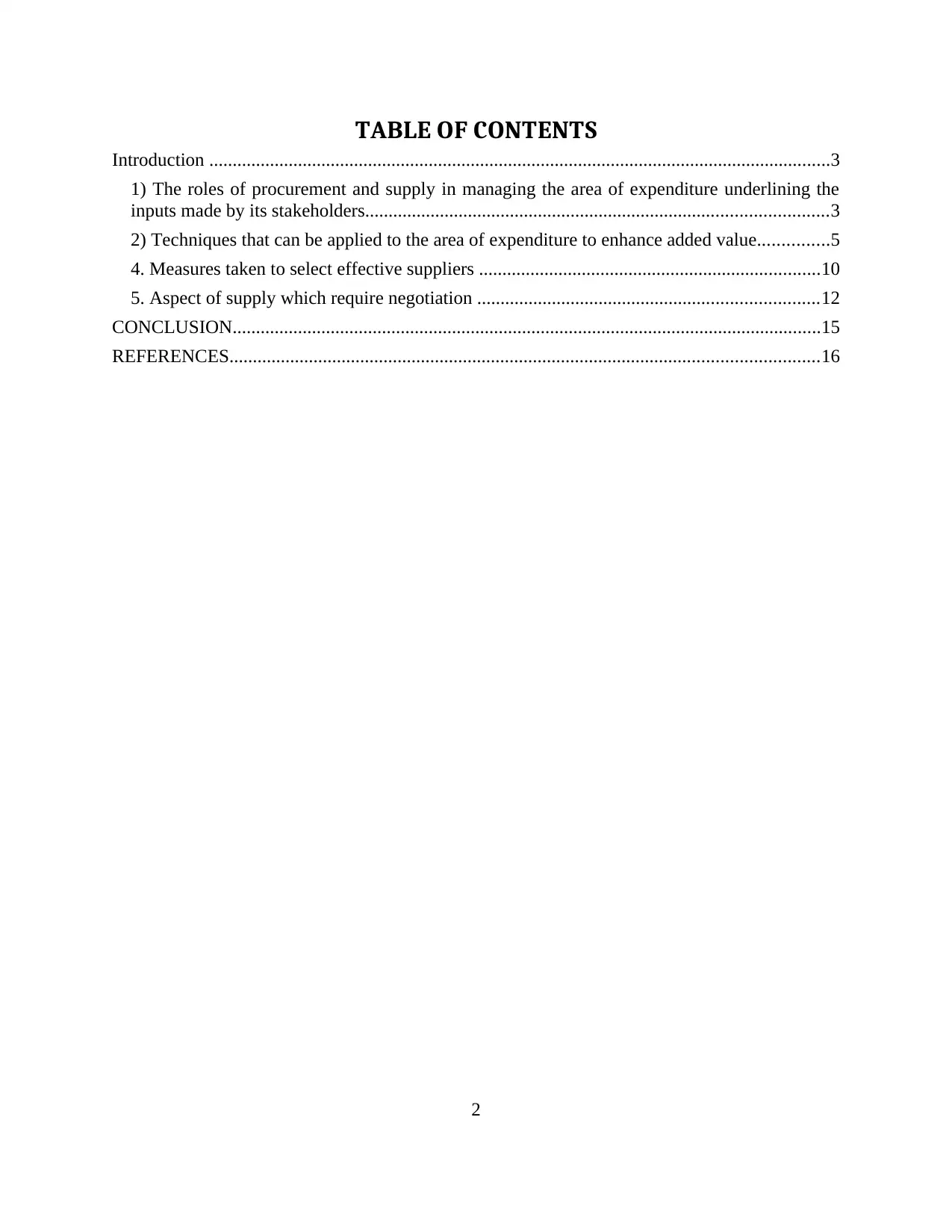
TABLE OF CONTENTS
Introduction .....................................................................................................................................3
1) The roles of procurement and supply in managing the area of expenditure underlining the
inputs made by its stakeholders...................................................................................................3
2) Techniques that can be applied to the area of expenditure to enhance added value...............5
4. Measures taken to select effective suppliers .........................................................................10
5. Aspect of supply which require negotiation .........................................................................12
CONCLUSION..............................................................................................................................15
REFERENCES..............................................................................................................................16
2
Introduction .....................................................................................................................................3
1) The roles of procurement and supply in managing the area of expenditure underlining the
inputs made by its stakeholders...................................................................................................3
2) Techniques that can be applied to the area of expenditure to enhance added value...............5
4. Measures taken to select effective suppliers .........................................................................10
5. Aspect of supply which require negotiation .........................................................................12
CONCLUSION..............................................................................................................................15
REFERENCES..............................................................................................................................16
2
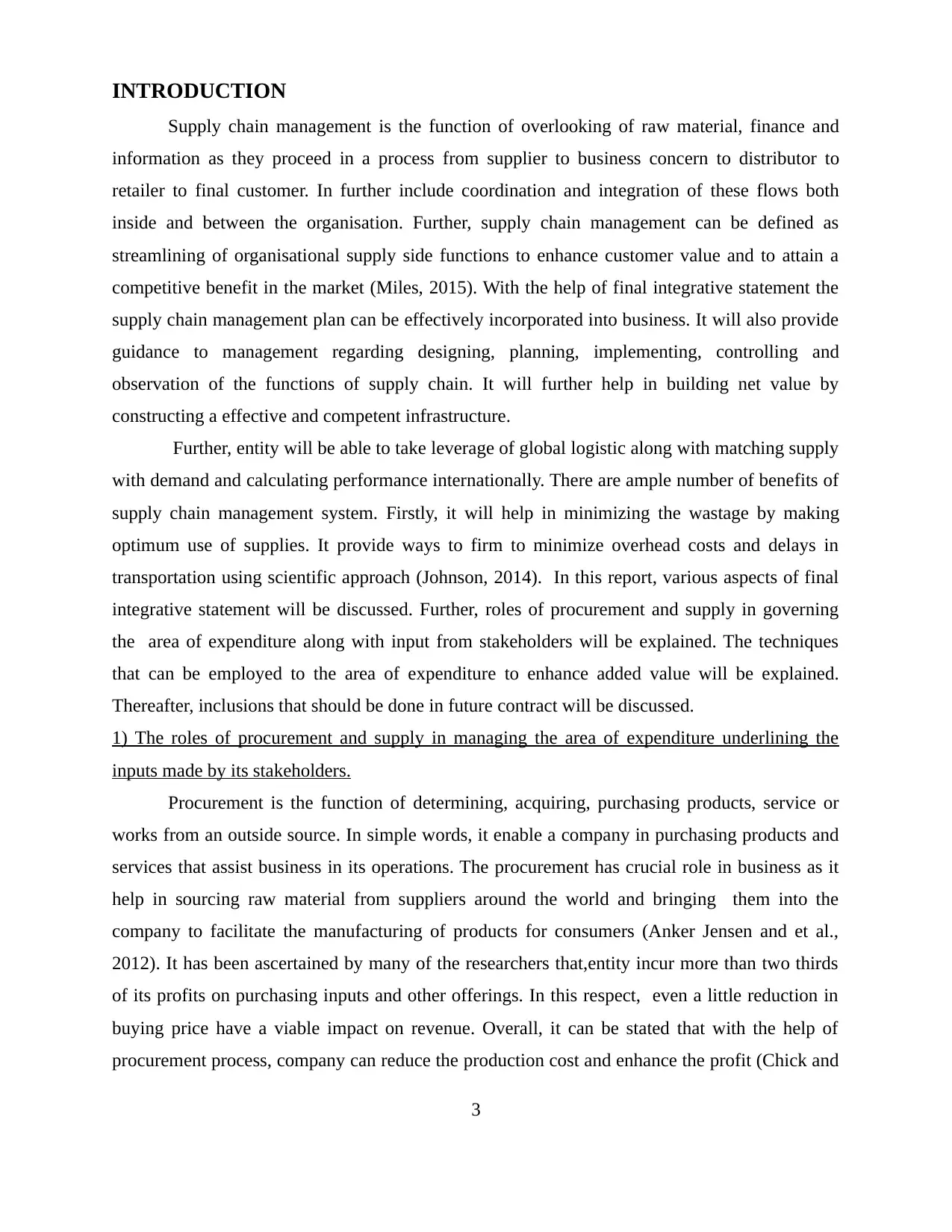
INTRODUCTION
Supply chain management is the function of overlooking of raw material, finance and
information as they proceed in a process from supplier to business concern to distributor to
retailer to final customer. In further include coordination and integration of these flows both
inside and between the organisation. Further, supply chain management can be defined as
streamlining of organisational supply side functions to enhance customer value and to attain a
competitive benefit in the market (Miles, 2015). With the help of final integrative statement the
supply chain management plan can be effectively incorporated into business. It will also provide
guidance to management regarding designing, planning, implementing, controlling and
observation of the functions of supply chain. It will further help in building net value by
constructing a effective and competent infrastructure.
Further, entity will be able to take leverage of global logistic along with matching supply
with demand and calculating performance internationally. There are ample number of benefits of
supply chain management system. Firstly, it will help in minimizing the wastage by making
optimum use of supplies. It provide ways to firm to minimize overhead costs and delays in
transportation using scientific approach (Johnson, 2014). In this report, various aspects of final
integrative statement will be discussed. Further, roles of procurement and supply in governing
the area of expenditure along with input from stakeholders will be explained. The techniques
that can be employed to the area of expenditure to enhance added value will be explained.
Thereafter, inclusions that should be done in future contract will be discussed.
1) The roles of procurement and supply in managing the area of expenditure underlining the
inputs made by its stakeholders.
Procurement is the function of determining, acquiring, purchasing products, service or
works from an outside source. In simple words, it enable a company in purchasing products and
services that assist business in its operations. The procurement has crucial role in business as it
help in sourcing raw material from suppliers around the world and bringing them into the
company to facilitate the manufacturing of products for consumers (Anker Jensen and et al.,
2012). It has been ascertained by many of the researchers that,entity incur more than two thirds
of its profits on purchasing inputs and other offerings. In this respect, even a little reduction in
buying price have a viable impact on revenue. Overall, it can be stated that with the help of
procurement process, company can reduce the production cost and enhance the profit (Chick and
3
Supply chain management is the function of overlooking of raw material, finance and
information as they proceed in a process from supplier to business concern to distributor to
retailer to final customer. In further include coordination and integration of these flows both
inside and between the organisation. Further, supply chain management can be defined as
streamlining of organisational supply side functions to enhance customer value and to attain a
competitive benefit in the market (Miles, 2015). With the help of final integrative statement the
supply chain management plan can be effectively incorporated into business. It will also provide
guidance to management regarding designing, planning, implementing, controlling and
observation of the functions of supply chain. It will further help in building net value by
constructing a effective and competent infrastructure.
Further, entity will be able to take leverage of global logistic along with matching supply
with demand and calculating performance internationally. There are ample number of benefits of
supply chain management system. Firstly, it will help in minimizing the wastage by making
optimum use of supplies. It provide ways to firm to minimize overhead costs and delays in
transportation using scientific approach (Johnson, 2014). In this report, various aspects of final
integrative statement will be discussed. Further, roles of procurement and supply in governing
the area of expenditure along with input from stakeholders will be explained. The techniques
that can be employed to the area of expenditure to enhance added value will be explained.
Thereafter, inclusions that should be done in future contract will be discussed.
1) The roles of procurement and supply in managing the area of expenditure underlining the
inputs made by its stakeholders.
Procurement is the function of determining, acquiring, purchasing products, service or
works from an outside source. In simple words, it enable a company in purchasing products and
services that assist business in its operations. The procurement has crucial role in business as it
help in sourcing raw material from suppliers around the world and bringing them into the
company to facilitate the manufacturing of products for consumers (Anker Jensen and et al.,
2012). It has been ascertained by many of the researchers that,entity incur more than two thirds
of its profits on purchasing inputs and other offerings. In this respect, even a little reduction in
buying price have a viable impact on revenue. Overall, it can be stated that with the help of
procurement process, company can reduce the production cost and enhance the profit (Chick and
3
⊘ This is a preview!⊘
Do you want full access?
Subscribe today to unlock all pages.

Trusted by 1+ million students worldwide
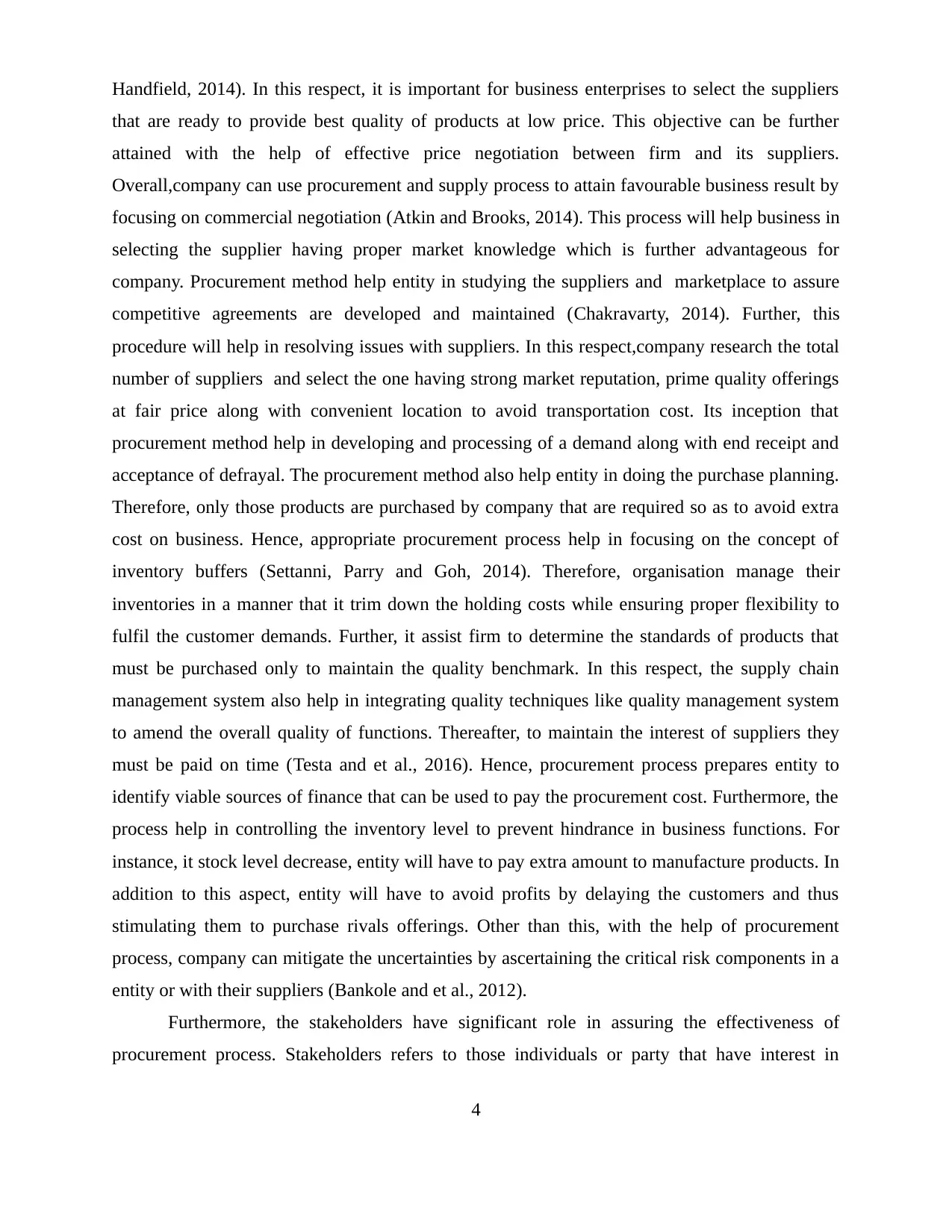
Handfield, 2014). In this respect, it is important for business enterprises to select the suppliers
that are ready to provide best quality of products at low price. This objective can be further
attained with the help of effective price negotiation between firm and its suppliers.
Overall,company can use procurement and supply process to attain favourable business result by
focusing on commercial negotiation (Atkin and Brooks, 2014). This process will help business in
selecting the supplier having proper market knowledge which is further advantageous for
company. Procurement method help entity in studying the suppliers and marketplace to assure
competitive agreements are developed and maintained (Chakravarty, 2014). Further, this
procedure will help in resolving issues with suppliers. In this respect,company research the total
number of suppliers and select the one having strong market reputation, prime quality offerings
at fair price along with convenient location to avoid transportation cost. Its inception that
procurement method help in developing and processing of a demand along with end receipt and
acceptance of defrayal. The procurement method also help entity in doing the purchase planning.
Therefore, only those products are purchased by company that are required so as to avoid extra
cost on business. Hence, appropriate procurement process help in focusing on the concept of
inventory buffers (Settanni, Parry and Goh, 2014). Therefore, organisation manage their
inventories in a manner that it trim down the holding costs while ensuring proper flexibility to
fulfil the customer demands. Further, it assist firm to determine the standards of products that
must be purchased only to maintain the quality benchmark. In this respect, the supply chain
management system also help in integrating quality techniques like quality management system
to amend the overall quality of functions. Thereafter, to maintain the interest of suppliers they
must be paid on time (Testa and et al., 2016). Hence, procurement process prepares entity to
identify viable sources of finance that can be used to pay the procurement cost. Furthermore, the
process help in controlling the inventory level to prevent hindrance in business functions. For
instance, it stock level decrease, entity will have to pay extra amount to manufacture products. In
addition to this aspect, entity will have to avoid profits by delaying the customers and thus
stimulating them to purchase rivals offerings. Other than this, with the help of procurement
process, company can mitigate the uncertainties by ascertaining the critical risk components in a
entity or with their suppliers (Bankole and et al., 2012).
Furthermore, the stakeholders have significant role in assuring the effectiveness of
procurement process. Stakeholders refers to those individuals or party that have interest in
4
that are ready to provide best quality of products at low price. This objective can be further
attained with the help of effective price negotiation between firm and its suppliers.
Overall,company can use procurement and supply process to attain favourable business result by
focusing on commercial negotiation (Atkin and Brooks, 2014). This process will help business in
selecting the supplier having proper market knowledge which is further advantageous for
company. Procurement method help entity in studying the suppliers and marketplace to assure
competitive agreements are developed and maintained (Chakravarty, 2014). Further, this
procedure will help in resolving issues with suppliers. In this respect,company research the total
number of suppliers and select the one having strong market reputation, prime quality offerings
at fair price along with convenient location to avoid transportation cost. Its inception that
procurement method help in developing and processing of a demand along with end receipt and
acceptance of defrayal. The procurement method also help entity in doing the purchase planning.
Therefore, only those products are purchased by company that are required so as to avoid extra
cost on business. Hence, appropriate procurement process help in focusing on the concept of
inventory buffers (Settanni, Parry and Goh, 2014). Therefore, organisation manage their
inventories in a manner that it trim down the holding costs while ensuring proper flexibility to
fulfil the customer demands. Further, it assist firm to determine the standards of products that
must be purchased only to maintain the quality benchmark. In this respect, the supply chain
management system also help in integrating quality techniques like quality management system
to amend the overall quality of functions. Thereafter, to maintain the interest of suppliers they
must be paid on time (Testa and et al., 2016). Hence, procurement process prepares entity to
identify viable sources of finance that can be used to pay the procurement cost. Furthermore, the
process help in controlling the inventory level to prevent hindrance in business functions. For
instance, it stock level decrease, entity will have to pay extra amount to manufacture products. In
addition to this aspect, entity will have to avoid profits by delaying the customers and thus
stimulating them to purchase rivals offerings. Other than this, with the help of procurement
process, company can mitigate the uncertainties by ascertaining the critical risk components in a
entity or with their suppliers (Bankole and et al., 2012).
Furthermore, the stakeholders have significant role in assuring the effectiveness of
procurement process. Stakeholders refers to those individuals or party that have interest in
4
Paraphrase This Document
Need a fresh take? Get an instant paraphrase of this document with our AI Paraphraser
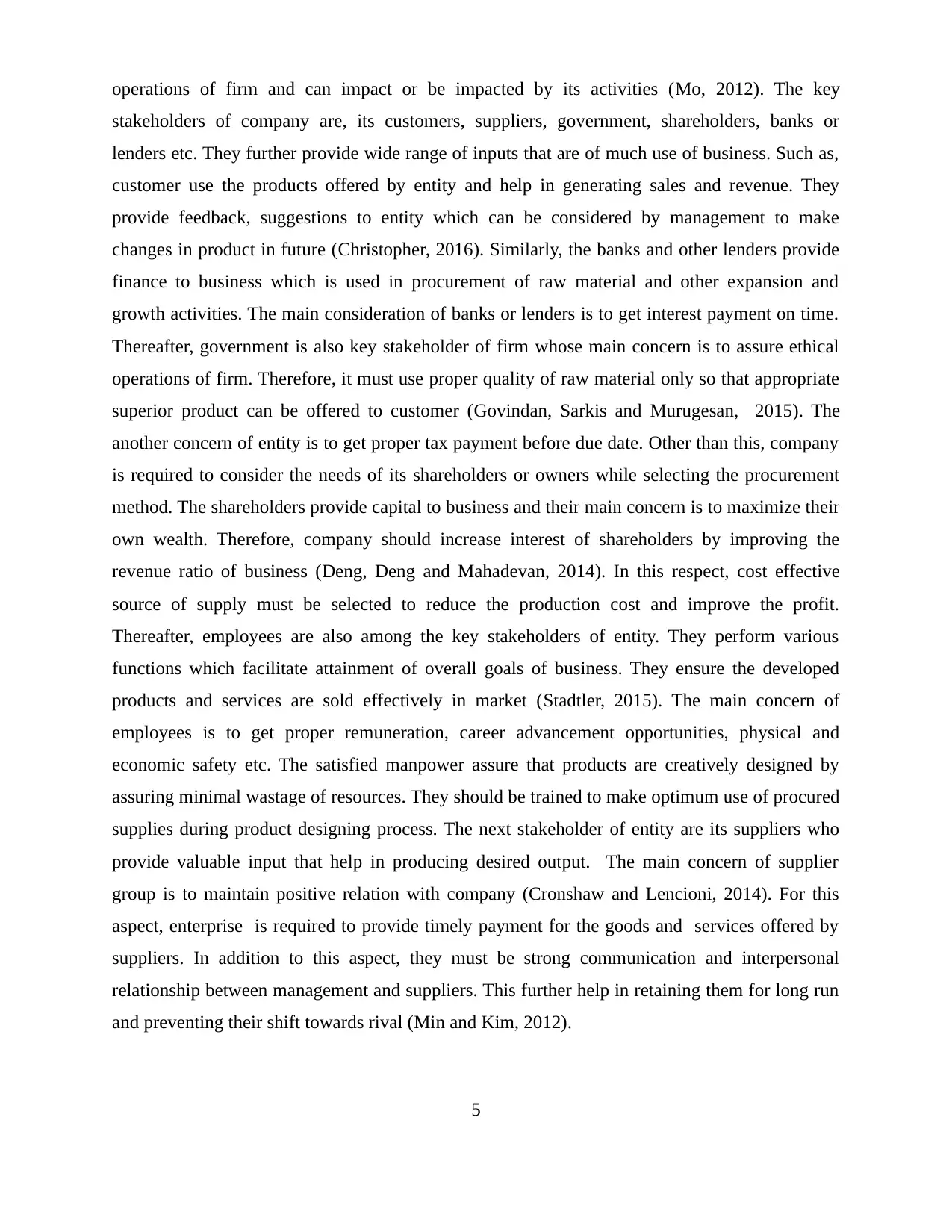
operations of firm and can impact or be impacted by its activities (Mo, 2012). The key
stakeholders of company are, its customers, suppliers, government, shareholders, banks or
lenders etc. They further provide wide range of inputs that are of much use of business. Such as,
customer use the products offered by entity and help in generating sales and revenue. They
provide feedback, suggestions to entity which can be considered by management to make
changes in product in future (Christopher, 2016). Similarly, the banks and other lenders provide
finance to business which is used in procurement of raw material and other expansion and
growth activities. The main consideration of banks or lenders is to get interest payment on time.
Thereafter, government is also key stakeholder of firm whose main concern is to assure ethical
operations of firm. Therefore, it must use proper quality of raw material only so that appropriate
superior product can be offered to customer (Govindan, Sarkis and Murugesan, 2015). The
another concern of entity is to get proper tax payment before due date. Other than this, company
is required to consider the needs of its shareholders or owners while selecting the procurement
method. The shareholders provide capital to business and their main concern is to maximize their
own wealth. Therefore, company should increase interest of shareholders by improving the
revenue ratio of business (Deng, Deng and Mahadevan, 2014). In this respect, cost effective
source of supply must be selected to reduce the production cost and improve the profit.
Thereafter, employees are also among the key stakeholders of entity. They perform various
functions which facilitate attainment of overall goals of business. They ensure the developed
products and services are sold effectively in market (Stadtler, 2015). The main concern of
employees is to get proper remuneration, career advancement opportunities, physical and
economic safety etc. The satisfied manpower assure that products are creatively designed by
assuring minimal wastage of resources. They should be trained to make optimum use of procured
supplies during product designing process. The next stakeholder of entity are its suppliers who
provide valuable input that help in producing desired output. The main concern of supplier
group is to maintain positive relation with company (Cronshaw and Lencioni, 2014). For this
aspect, enterprise is required to provide timely payment for the goods and services offered by
suppliers. In addition to this aspect, they must be strong communication and interpersonal
relationship between management and suppliers. This further help in retaining them for long run
and preventing their shift towards rival (Min and Kim, 2012).
5
stakeholders of company are, its customers, suppliers, government, shareholders, banks or
lenders etc. They further provide wide range of inputs that are of much use of business. Such as,
customer use the products offered by entity and help in generating sales and revenue. They
provide feedback, suggestions to entity which can be considered by management to make
changes in product in future (Christopher, 2016). Similarly, the banks and other lenders provide
finance to business which is used in procurement of raw material and other expansion and
growth activities. The main consideration of banks or lenders is to get interest payment on time.
Thereafter, government is also key stakeholder of firm whose main concern is to assure ethical
operations of firm. Therefore, it must use proper quality of raw material only so that appropriate
superior product can be offered to customer (Govindan, Sarkis and Murugesan, 2015). The
another concern of entity is to get proper tax payment before due date. Other than this, company
is required to consider the needs of its shareholders or owners while selecting the procurement
method. The shareholders provide capital to business and their main concern is to maximize their
own wealth. Therefore, company should increase interest of shareholders by improving the
revenue ratio of business (Deng, Deng and Mahadevan, 2014). In this respect, cost effective
source of supply must be selected to reduce the production cost and improve the profit.
Thereafter, employees are also among the key stakeholders of entity. They perform various
functions which facilitate attainment of overall goals of business. They ensure the developed
products and services are sold effectively in market (Stadtler, 2015). The main concern of
employees is to get proper remuneration, career advancement opportunities, physical and
economic safety etc. The satisfied manpower assure that products are creatively designed by
assuring minimal wastage of resources. They should be trained to make optimum use of procured
supplies during product designing process. The next stakeholder of entity are its suppliers who
provide valuable input that help in producing desired output. The main concern of supplier
group is to maintain positive relation with company (Cronshaw and Lencioni, 2014). For this
aspect, enterprise is required to provide timely payment for the goods and services offered by
suppliers. In addition to this aspect, they must be strong communication and interpersonal
relationship between management and suppliers. This further help in retaining them for long run
and preventing their shift towards rival (Min and Kim, 2012).
5
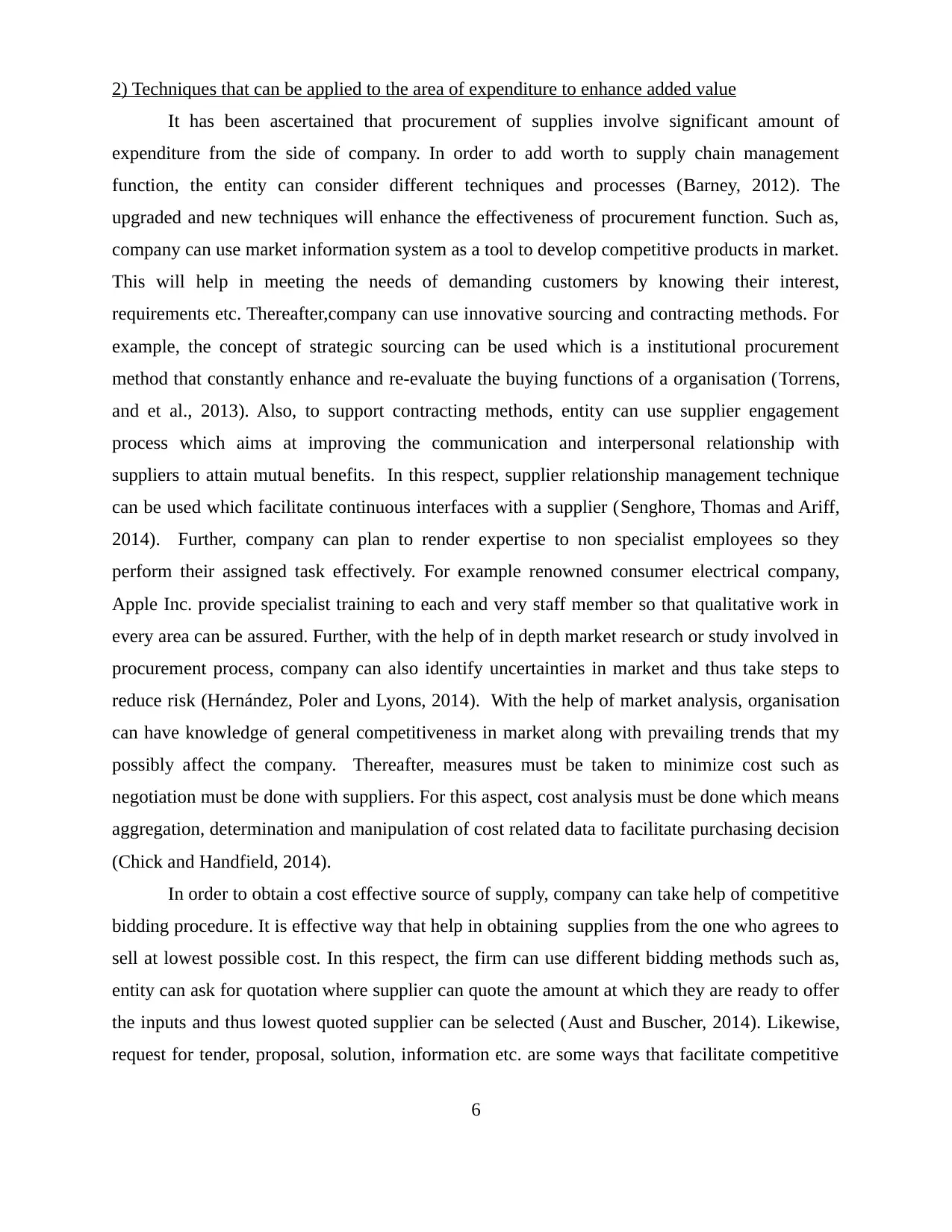
2) Techniques that can be applied to the area of expenditure to enhance added value
It has been ascertained that procurement of supplies involve significant amount of
expenditure from the side of company. In order to add worth to supply chain management
function, the entity can consider different techniques and processes (Barney, 2012). The
upgraded and new techniques will enhance the effectiveness of procurement function. Such as,
company can use market information system as a tool to develop competitive products in market.
This will help in meeting the needs of demanding customers by knowing their interest,
requirements etc. Thereafter,company can use innovative sourcing and contracting methods. For
example, the concept of strategic sourcing can be used which is a institutional procurement
method that constantly enhance and re-evaluate the buying functions of a organisation (Torrens,
and et al., 2013). Also, to support contracting methods, entity can use supplier engagement
process which aims at improving the communication and interpersonal relationship with
suppliers to attain mutual benefits. In this respect, supplier relationship management technique
can be used which facilitate continuous interfaces with a supplier (Senghore, Thomas and Ariff,
2014). Further, company can plan to render expertise to non specialist employees so they
perform their assigned task effectively. For example renowned consumer electrical company,
Apple Inc. provide specialist training to each and very staff member so that qualitative work in
every area can be assured. Further, with the help of in depth market research or study involved in
procurement process, company can also identify uncertainties in market and thus take steps to
reduce risk (Hernández, Poler and Lyons, 2014). With the help of market analysis, organisation
can have knowledge of general competitiveness in market along with prevailing trends that my
possibly affect the company. Thereafter, measures must be taken to minimize cost such as
negotiation must be done with suppliers. For this aspect, cost analysis must be done which means
aggregation, determination and manipulation of cost related data to facilitate purchasing decision
(Chick and Handfield, 2014).
In order to obtain a cost effective source of supply, company can take help of competitive
bidding procedure. It is effective way that help in obtaining supplies from the one who agrees to
sell at lowest possible cost. In this respect, the firm can use different bidding methods such as,
entity can ask for quotation where supplier can quote the amount at which they are ready to offer
the inputs and thus lowest quoted supplier can be selected (Aust and Buscher, 2014). Likewise,
request for tender, proposal, solution, information etc. are some ways that facilitate competitive
6
It has been ascertained that procurement of supplies involve significant amount of
expenditure from the side of company. In order to add worth to supply chain management
function, the entity can consider different techniques and processes (Barney, 2012). The
upgraded and new techniques will enhance the effectiveness of procurement function. Such as,
company can use market information system as a tool to develop competitive products in market.
This will help in meeting the needs of demanding customers by knowing their interest,
requirements etc. Thereafter,company can use innovative sourcing and contracting methods. For
example, the concept of strategic sourcing can be used which is a institutional procurement
method that constantly enhance and re-evaluate the buying functions of a organisation (Torrens,
and et al., 2013). Also, to support contracting methods, entity can use supplier engagement
process which aims at improving the communication and interpersonal relationship with
suppliers to attain mutual benefits. In this respect, supplier relationship management technique
can be used which facilitate continuous interfaces with a supplier (Senghore, Thomas and Ariff,
2014). Further, company can plan to render expertise to non specialist employees so they
perform their assigned task effectively. For example renowned consumer electrical company,
Apple Inc. provide specialist training to each and very staff member so that qualitative work in
every area can be assured. Further, with the help of in depth market research or study involved in
procurement process, company can also identify uncertainties in market and thus take steps to
reduce risk (Hernández, Poler and Lyons, 2014). With the help of market analysis, organisation
can have knowledge of general competitiveness in market along with prevailing trends that my
possibly affect the company. Thereafter, measures must be taken to minimize cost such as
negotiation must be done with suppliers. For this aspect, cost analysis must be done which means
aggregation, determination and manipulation of cost related data to facilitate purchasing decision
(Chick and Handfield, 2014).
In order to obtain a cost effective source of supply, company can take help of competitive
bidding procedure. It is effective way that help in obtaining supplies from the one who agrees to
sell at lowest possible cost. In this respect, the firm can use different bidding methods such as,
entity can ask for quotation where supplier can quote the amount at which they are ready to offer
the inputs and thus lowest quoted supplier can be selected (Aust and Buscher, 2014). Likewise,
request for tender, proposal, solution, information etc. are some ways that facilitate competitive
6
⊘ This is a preview!⊘
Do you want full access?
Subscribe today to unlock all pages.

Trusted by 1+ million students worldwide
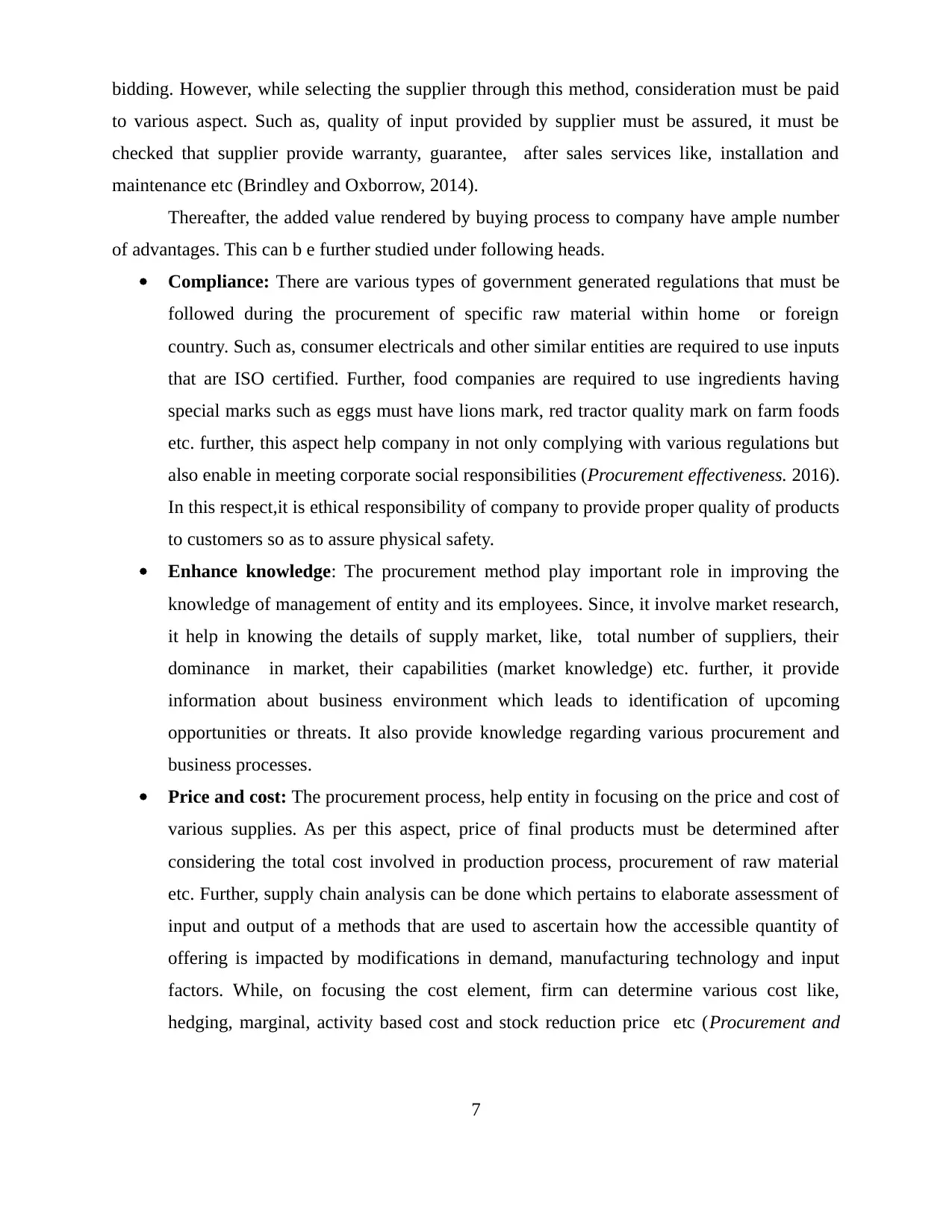
bidding. However, while selecting the supplier through this method, consideration must be paid
to various aspect. Such as, quality of input provided by supplier must be assured, it must be
checked that supplier provide warranty, guarantee, after sales services like, installation and
maintenance etc (Brindley and Oxborrow, 2014).
Thereafter, the added value rendered by buying process to company have ample number
of advantages. This can b e further studied under following heads.
Compliance: There are various types of government generated regulations that must be
followed during the procurement of specific raw material within home or foreign
country. Such as, consumer electricals and other similar entities are required to use inputs
that are ISO certified. Further, food companies are required to use ingredients having
special marks such as eggs must have lions mark, red tractor quality mark on farm foods
etc. further, this aspect help company in not only complying with various regulations but
also enable in meeting corporate social responsibilities (Procurement effectiveness. 2016).
In this respect,it is ethical responsibility of company to provide proper quality of products
to customers so as to assure physical safety.
Enhance knowledge: The procurement method play important role in improving the
knowledge of management of entity and its employees. Since, it involve market research,
it help in knowing the details of supply market, like, total number of suppliers, their
dominance in market, their capabilities (market knowledge) etc. further, it provide
information about business environment which leads to identification of upcoming
opportunities or threats. It also provide knowledge regarding various procurement and
business processes.
Price and cost: The procurement process, help entity in focusing on the price and cost of
various supplies. As per this aspect, price of final products must be determined after
considering the total cost involved in production process, procurement of raw material
etc. Further, supply chain analysis can be done which pertains to elaborate assessment of
input and output of a methods that are used to ascertain how the accessible quantity of
offering is impacted by modifications in demand, manufacturing technology and input
factors. While, on focusing the cost element, firm can determine various cost like,
hedging, marginal, activity based cost and stock reduction price etc (Procurement and
7
to various aspect. Such as, quality of input provided by supplier must be assured, it must be
checked that supplier provide warranty, guarantee, after sales services like, installation and
maintenance etc (Brindley and Oxborrow, 2014).
Thereafter, the added value rendered by buying process to company have ample number
of advantages. This can b e further studied under following heads.
Compliance: There are various types of government generated regulations that must be
followed during the procurement of specific raw material within home or foreign
country. Such as, consumer electricals and other similar entities are required to use inputs
that are ISO certified. Further, food companies are required to use ingredients having
special marks such as eggs must have lions mark, red tractor quality mark on farm foods
etc. further, this aspect help company in not only complying with various regulations but
also enable in meeting corporate social responsibilities (Procurement effectiveness. 2016).
In this respect,it is ethical responsibility of company to provide proper quality of products
to customers so as to assure physical safety.
Enhance knowledge: The procurement method play important role in improving the
knowledge of management of entity and its employees. Since, it involve market research,
it help in knowing the details of supply market, like, total number of suppliers, their
dominance in market, their capabilities (market knowledge) etc. further, it provide
information about business environment which leads to identification of upcoming
opportunities or threats. It also provide knowledge regarding various procurement and
business processes.
Price and cost: The procurement process, help entity in focusing on the price and cost of
various supplies. As per this aspect, price of final products must be determined after
considering the total cost involved in production process, procurement of raw material
etc. Further, supply chain analysis can be done which pertains to elaborate assessment of
input and output of a methods that are used to ascertain how the accessible quantity of
offering is impacted by modifications in demand, manufacturing technology and input
factors. While, on focusing the cost element, firm can determine various cost like,
hedging, marginal, activity based cost and stock reduction price etc (Procurement and
7
Paraphrase This Document
Need a fresh take? Get an instant paraphrase of this document with our AI Paraphraser
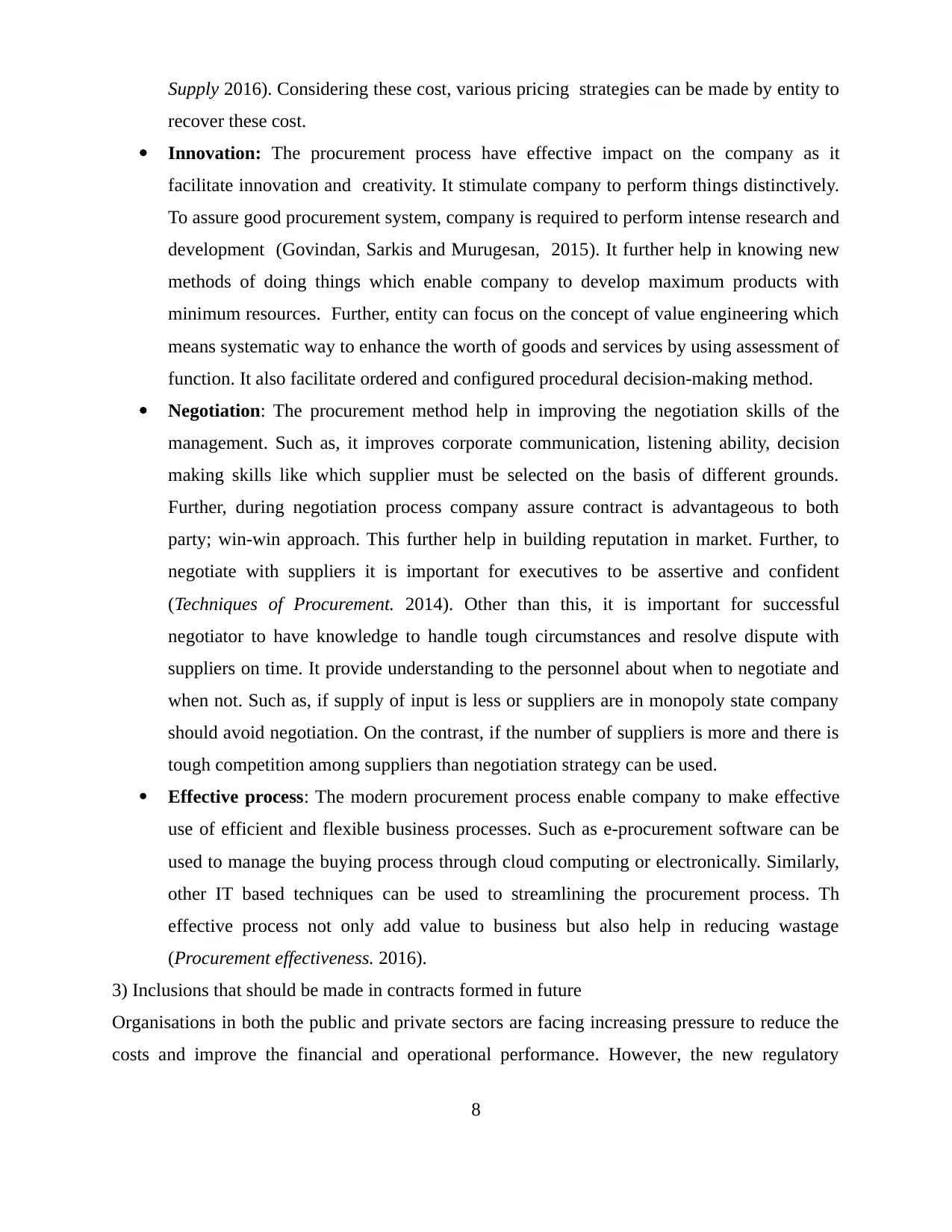
Supply 2016). Considering these cost, various pricing strategies can be made by entity to
recover these cost.
Innovation: The procurement process have effective impact on the company as it
facilitate innovation and creativity. It stimulate company to perform things distinctively.
To assure good procurement system, company is required to perform intense research and
development (Govindan, Sarkis and Murugesan, 2015). It further help in knowing new
methods of doing things which enable company to develop maximum products with
minimum resources. Further, entity can focus on the concept of value engineering which
means systematic way to enhance the worth of goods and services by using assessment of
function. It also facilitate ordered and configured procedural decision-making method.
Negotiation: The procurement method help in improving the negotiation skills of the
management. Such as, it improves corporate communication, listening ability, decision
making skills like which supplier must be selected on the basis of different grounds.
Further, during negotiation process company assure contract is advantageous to both
party; win-win approach. This further help in building reputation in market. Further, to
negotiate with suppliers it is important for executives to be assertive and confident
(Techniques of Procurement. 2014). Other than this, it is important for successful
negotiator to have knowledge to handle tough circumstances and resolve dispute with
suppliers on time. It provide understanding to the personnel about when to negotiate and
when not. Such as, if supply of input is less or suppliers are in monopoly state company
should avoid negotiation. On the contrast, if the number of suppliers is more and there is
tough competition among suppliers than negotiation strategy can be used.
Effective process: The modern procurement process enable company to make effective
use of efficient and flexible business processes. Such as e-procurement software can be
used to manage the buying process through cloud computing or electronically. Similarly,
other IT based techniques can be used to streamlining the procurement process. Th
effective process not only add value to business but also help in reducing wastage
(Procurement effectiveness. 2016).
3) Inclusions that should be made in contracts formed in future
Organisations in both the public and private sectors are facing increasing pressure to reduce the
costs and improve the financial and operational performance. However, the new regulatory
8
recover these cost.
Innovation: The procurement process have effective impact on the company as it
facilitate innovation and creativity. It stimulate company to perform things distinctively.
To assure good procurement system, company is required to perform intense research and
development (Govindan, Sarkis and Murugesan, 2015). It further help in knowing new
methods of doing things which enable company to develop maximum products with
minimum resources. Further, entity can focus on the concept of value engineering which
means systematic way to enhance the worth of goods and services by using assessment of
function. It also facilitate ordered and configured procedural decision-making method.
Negotiation: The procurement method help in improving the negotiation skills of the
management. Such as, it improves corporate communication, listening ability, decision
making skills like which supplier must be selected on the basis of different grounds.
Further, during negotiation process company assure contract is advantageous to both
party; win-win approach. This further help in building reputation in market. Further, to
negotiate with suppliers it is important for executives to be assertive and confident
(Techniques of Procurement. 2014). Other than this, it is important for successful
negotiator to have knowledge to handle tough circumstances and resolve dispute with
suppliers on time. It provide understanding to the personnel about when to negotiate and
when not. Such as, if supply of input is less or suppliers are in monopoly state company
should avoid negotiation. On the contrast, if the number of suppliers is more and there is
tough competition among suppliers than negotiation strategy can be used.
Effective process: The modern procurement process enable company to make effective
use of efficient and flexible business processes. Such as e-procurement software can be
used to manage the buying process through cloud computing or electronically. Similarly,
other IT based techniques can be used to streamlining the procurement process. Th
effective process not only add value to business but also help in reducing wastage
(Procurement effectiveness. 2016).
3) Inclusions that should be made in contracts formed in future
Organisations in both the public and private sectors are facing increasing pressure to reduce the
costs and improve the financial and operational performance. However, the new regulatory
8
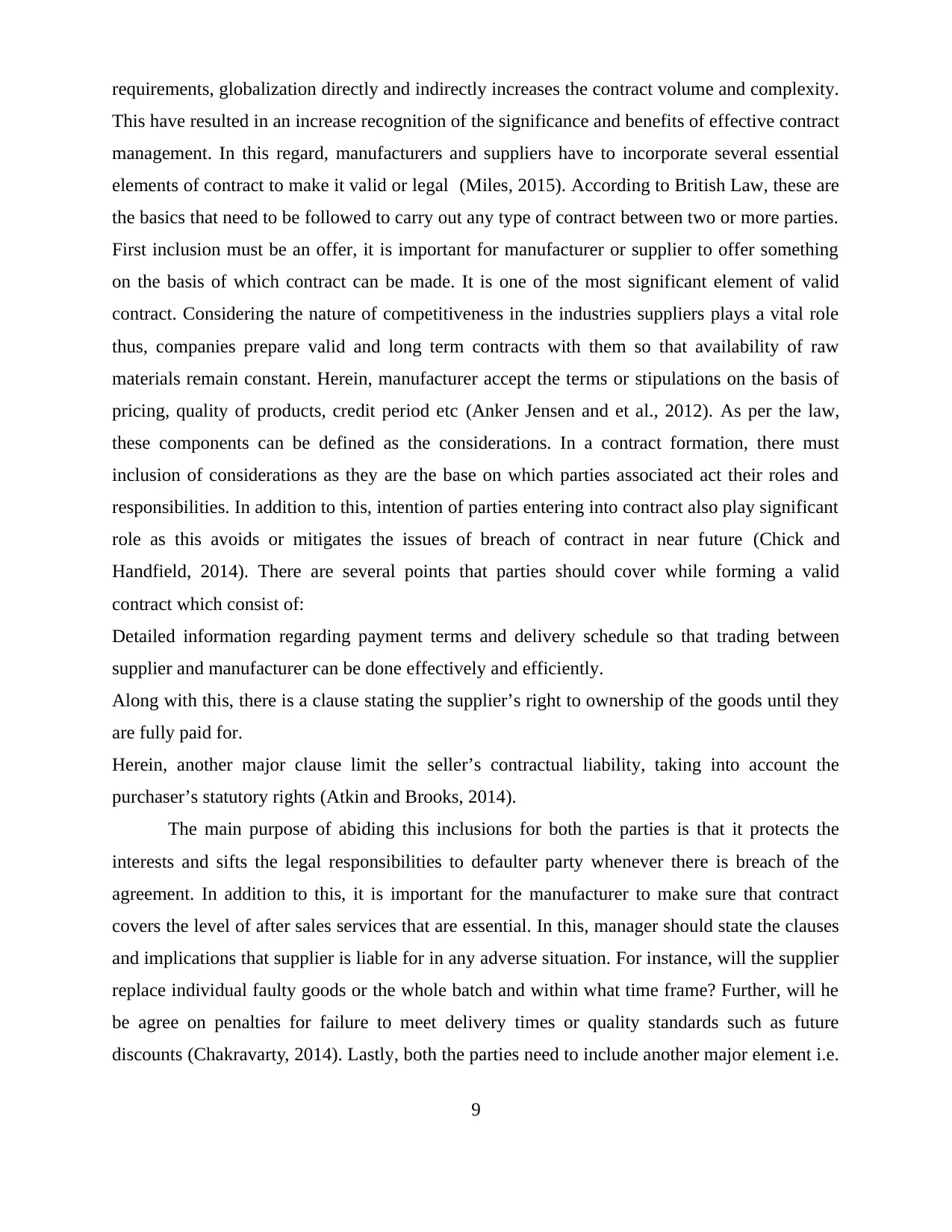
requirements, globalization directly and indirectly increases the contract volume and complexity.
This have resulted in an increase recognition of the significance and benefits of effective contract
management. In this regard, manufacturers and suppliers have to incorporate several essential
elements of contract to make it valid or legal (Miles, 2015). According to British Law, these are
the basics that need to be followed to carry out any type of contract between two or more parties.
First inclusion must be an offer, it is important for manufacturer or supplier to offer something
on the basis of which contract can be made. It is one of the most significant element of valid
contract. Considering the nature of competitiveness in the industries suppliers plays a vital role
thus, companies prepare valid and long term contracts with them so that availability of raw
materials remain constant. Herein, manufacturer accept the terms or stipulations on the basis of
pricing, quality of products, credit period etc (Anker Jensen and et al., 2012). As per the law,
these components can be defined as the considerations. In a contract formation, there must
inclusion of considerations as they are the base on which parties associated act their roles and
responsibilities. In addition to this, intention of parties entering into contract also play significant
role as this avoids or mitigates the issues of breach of contract in near future (Chick and
Handfield, 2014). There are several points that parties should cover while forming a valid
contract which consist of:
Detailed information regarding payment terms and delivery schedule so that trading between
supplier and manufacturer can be done effectively and efficiently.
Along with this, there is a clause stating the supplier’s right to ownership of the goods until they
are fully paid for.
Herein, another major clause limit the seller’s contractual liability, taking into account the
purchaser’s statutory rights (Atkin and Brooks, 2014).
The main purpose of abiding this inclusions for both the parties is that it protects the
interests and sifts the legal responsibilities to defaulter party whenever there is breach of the
agreement. In addition to this, it is important for the manufacturer to make sure that contract
covers the level of after sales services that are essential. In this, manager should state the clauses
and implications that supplier is liable for in any adverse situation. For instance, will the supplier
replace individual faulty goods or the whole batch and within what time frame? Further, will he
be agree on penalties for failure to meet delivery times or quality standards such as future
discounts (Chakravarty, 2014). Lastly, both the parties need to include another major element i.e.
9
This have resulted in an increase recognition of the significance and benefits of effective contract
management. In this regard, manufacturers and suppliers have to incorporate several essential
elements of contract to make it valid or legal (Miles, 2015). According to British Law, these are
the basics that need to be followed to carry out any type of contract between two or more parties.
First inclusion must be an offer, it is important for manufacturer or supplier to offer something
on the basis of which contract can be made. It is one of the most significant element of valid
contract. Considering the nature of competitiveness in the industries suppliers plays a vital role
thus, companies prepare valid and long term contracts with them so that availability of raw
materials remain constant. Herein, manufacturer accept the terms or stipulations on the basis of
pricing, quality of products, credit period etc (Anker Jensen and et al., 2012). As per the law,
these components can be defined as the considerations. In a contract formation, there must
inclusion of considerations as they are the base on which parties associated act their roles and
responsibilities. In addition to this, intention of parties entering into contract also play significant
role as this avoids or mitigates the issues of breach of contract in near future (Chick and
Handfield, 2014). There are several points that parties should cover while forming a valid
contract which consist of:
Detailed information regarding payment terms and delivery schedule so that trading between
supplier and manufacturer can be done effectively and efficiently.
Along with this, there is a clause stating the supplier’s right to ownership of the goods until they
are fully paid for.
Herein, another major clause limit the seller’s contractual liability, taking into account the
purchaser’s statutory rights (Atkin and Brooks, 2014).
The main purpose of abiding this inclusions for both the parties is that it protects the
interests and sifts the legal responsibilities to defaulter party whenever there is breach of the
agreement. In addition to this, it is important for the manufacturer to make sure that contract
covers the level of after sales services that are essential. In this, manager should state the clauses
and implications that supplier is liable for in any adverse situation. For instance, will the supplier
replace individual faulty goods or the whole batch and within what time frame? Further, will he
be agree on penalties for failure to meet delivery times or quality standards such as future
discounts (Chakravarty, 2014). Lastly, both the parties need to include another major element i.e.
9
⊘ This is a preview!⊘
Do you want full access?
Subscribe today to unlock all pages.

Trusted by 1+ million students worldwide

exit procedures. At the time of any dispute or conflict, innocent party have right to exit from the
contract thus, its process much be stated at the time of forming the agreement. By the means of
this parties can ensure that, exit procedure can be followed of either party is dissatisfied with the
relationship and wanted to end the contract.
10
contract thus, its process much be stated at the time of forming the agreement. By the means of
this parties can ensure that, exit procedure can be followed of either party is dissatisfied with the
relationship and wanted to end the contract.
10
Paraphrase This Document
Need a fresh take? Get an instant paraphrase of this document with our AI Paraphraser
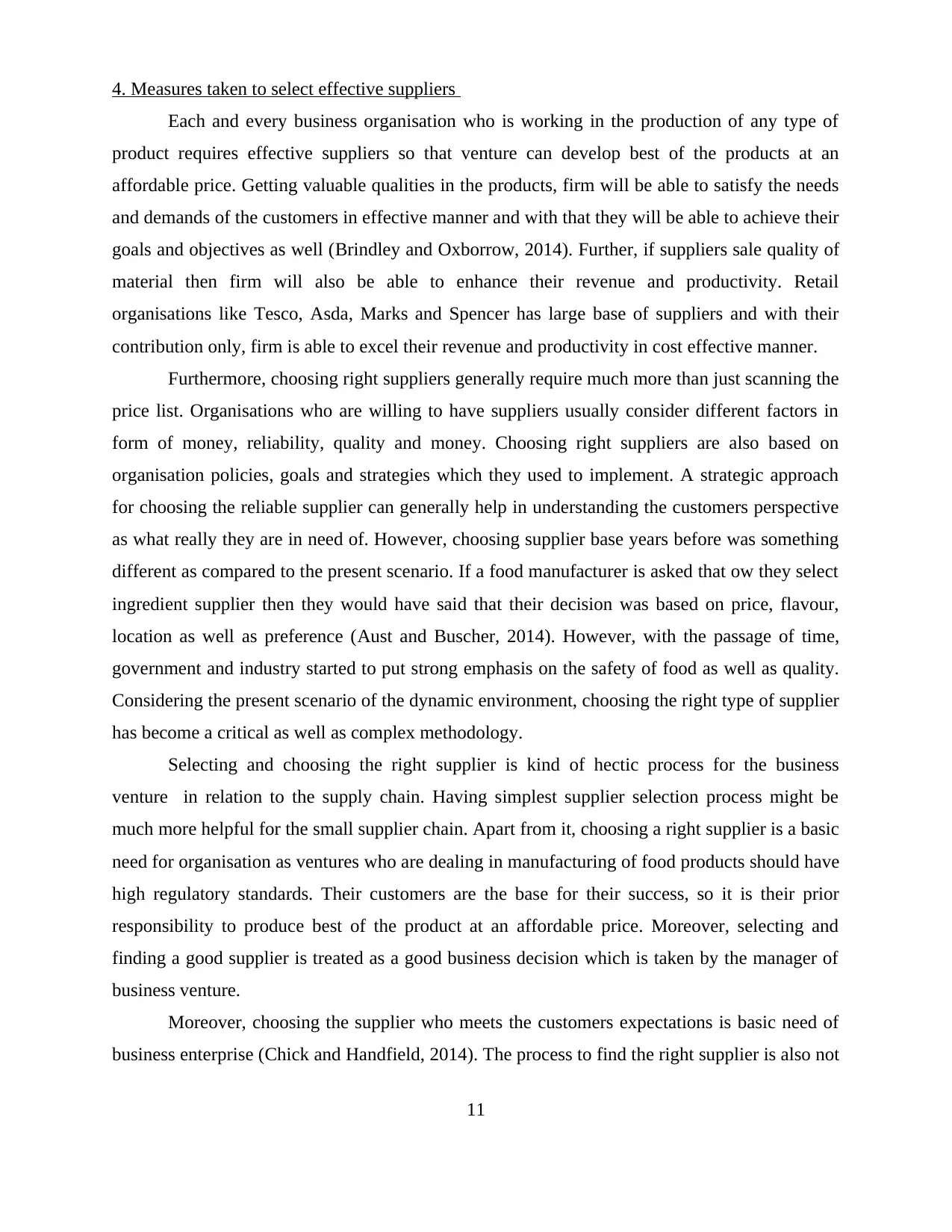
4. Measures taken to select effective suppliers
Each and every business organisation who is working in the production of any type of
product requires effective suppliers so that venture can develop best of the products at an
affordable price. Getting valuable qualities in the products, firm will be able to satisfy the needs
and demands of the customers in effective manner and with that they will be able to achieve their
goals and objectives as well (Brindley and Oxborrow, 2014). Further, if suppliers sale quality of
material then firm will also be able to enhance their revenue and productivity. Retail
organisations like Tesco, Asda, Marks and Spencer has large base of suppliers and with their
contribution only, firm is able to excel their revenue and productivity in cost effective manner.
Furthermore, choosing right suppliers generally require much more than just scanning the
price list. Organisations who are willing to have suppliers usually consider different factors in
form of money, reliability, quality and money. Choosing right suppliers are also based on
organisation policies, goals and strategies which they used to implement. A strategic approach
for choosing the reliable supplier can generally help in understanding the customers perspective
as what really they are in need of. However, choosing supplier base years before was something
different as compared to the present scenario. If a food manufacturer is asked that ow they select
ingredient supplier then they would have said that their decision was based on price, flavour,
location as well as preference (Aust and Buscher, 2014). However, with the passage of time,
government and industry started to put strong emphasis on the safety of food as well as quality.
Considering the present scenario of the dynamic environment, choosing the right type of supplier
has become a critical as well as complex methodology.
Selecting and choosing the right supplier is kind of hectic process for the business
venture in relation to the supply chain. Having simplest supplier selection process might be
much more helpful for the small supplier chain. Apart from it, choosing a right supplier is a basic
need for organisation as ventures who are dealing in manufacturing of food products should have
high regulatory standards. Their customers are the base for their success, so it is their prior
responsibility to produce best of the product at an affordable price. Moreover, selecting and
finding a good supplier is treated as a good business decision which is taken by the manager of
business venture.
Moreover, choosing the supplier who meets the customers expectations is basic need of
business enterprise (Chick and Handfield, 2014). The process to find the right supplier is also not
11
Each and every business organisation who is working in the production of any type of
product requires effective suppliers so that venture can develop best of the products at an
affordable price. Getting valuable qualities in the products, firm will be able to satisfy the needs
and demands of the customers in effective manner and with that they will be able to achieve their
goals and objectives as well (Brindley and Oxborrow, 2014). Further, if suppliers sale quality of
material then firm will also be able to enhance their revenue and productivity. Retail
organisations like Tesco, Asda, Marks and Spencer has large base of suppliers and with their
contribution only, firm is able to excel their revenue and productivity in cost effective manner.
Furthermore, choosing right suppliers generally require much more than just scanning the
price list. Organisations who are willing to have suppliers usually consider different factors in
form of money, reliability, quality and money. Choosing right suppliers are also based on
organisation policies, goals and strategies which they used to implement. A strategic approach
for choosing the reliable supplier can generally help in understanding the customers perspective
as what really they are in need of. However, choosing supplier base years before was something
different as compared to the present scenario. If a food manufacturer is asked that ow they select
ingredient supplier then they would have said that their decision was based on price, flavour,
location as well as preference (Aust and Buscher, 2014). However, with the passage of time,
government and industry started to put strong emphasis on the safety of food as well as quality.
Considering the present scenario of the dynamic environment, choosing the right type of supplier
has become a critical as well as complex methodology.
Selecting and choosing the right supplier is kind of hectic process for the business
venture in relation to the supply chain. Having simplest supplier selection process might be
much more helpful for the small supplier chain. Apart from it, choosing a right supplier is a basic
need for organisation as ventures who are dealing in manufacturing of food products should have
high regulatory standards. Their customers are the base for their success, so it is their prior
responsibility to produce best of the product at an affordable price. Moreover, selecting and
finding a good supplier is treated as a good business decision which is taken by the manager of
business venture.
Moreover, choosing the supplier who meets the customers expectations is basic need of
business enterprise (Chick and Handfield, 2014). The process to find the right supplier is also not
11
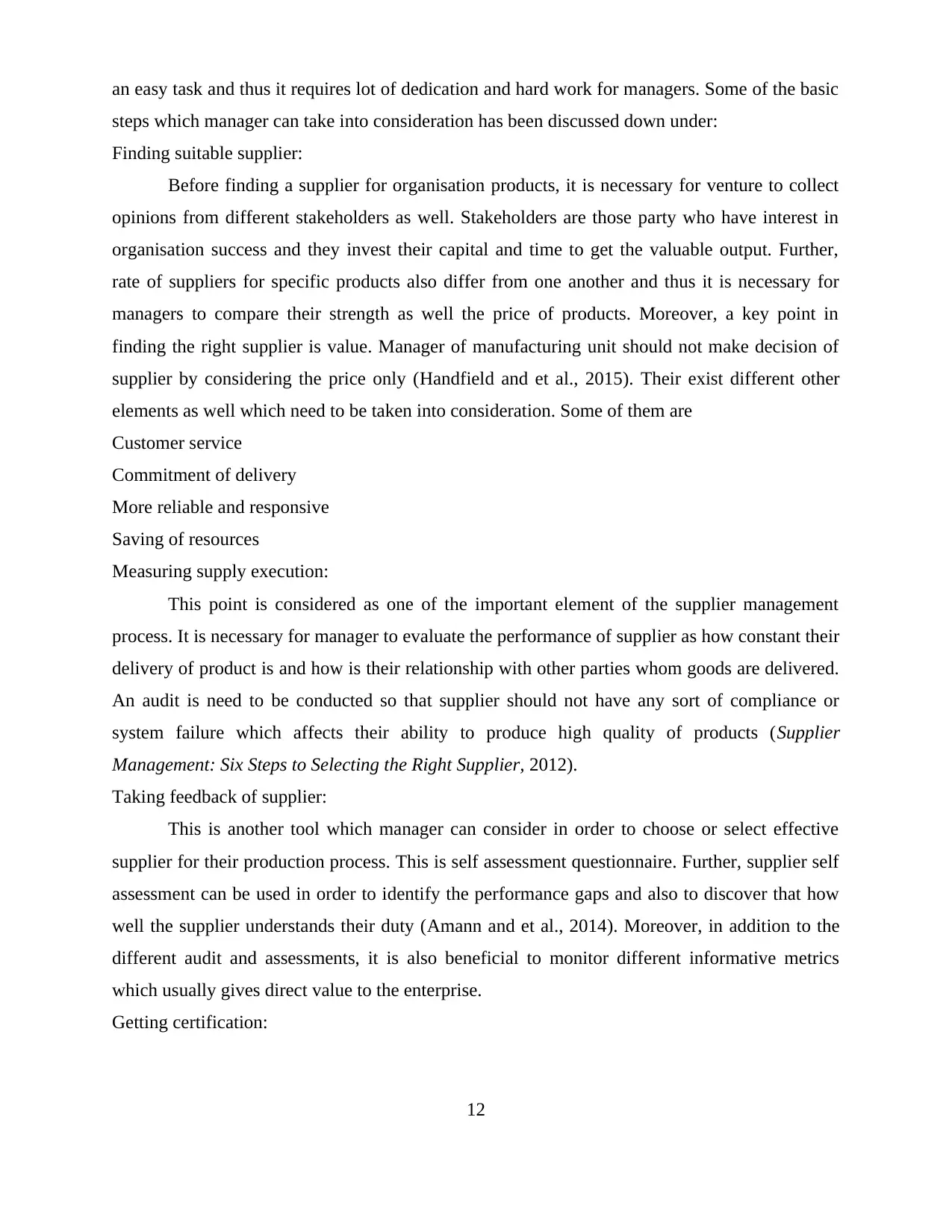
an easy task and thus it requires lot of dedication and hard work for managers. Some of the basic
steps which manager can take into consideration has been discussed down under:
Finding suitable supplier:
Before finding a supplier for organisation products, it is necessary for venture to collect
opinions from different stakeholders as well. Stakeholders are those party who have interest in
organisation success and they invest their capital and time to get the valuable output. Further,
rate of suppliers for specific products also differ from one another and thus it is necessary for
managers to compare their strength as well the price of products. Moreover, a key point in
finding the right supplier is value. Manager of manufacturing unit should not make decision of
supplier by considering the price only (Handfield and et al., 2015). Their exist different other
elements as well which need to be taken into consideration. Some of them are
Customer service
Commitment of delivery
More reliable and responsive
Saving of resources
Measuring supply execution:
This point is considered as one of the important element of the supplier management
process. It is necessary for manager to evaluate the performance of supplier as how constant their
delivery of product is and how is their relationship with other parties whom goods are delivered.
An audit is need to be conducted so that supplier should not have any sort of compliance or
system failure which affects their ability to produce high quality of products (Supplier
Management: Six Steps to Selecting the Right Supplier, 2012).
Taking feedback of supplier:
This is another tool which manager can consider in order to choose or select effective
supplier for their production process. This is self assessment questionnaire. Further, supplier self
assessment can be used in order to identify the performance gaps and also to discover that how
well the supplier understands their duty (Amann and et al., 2014). Moreover, in addition to the
different audit and assessments, it is also beneficial to monitor different informative metrics
which usually gives direct value to the enterprise.
Getting certification:
12
steps which manager can take into consideration has been discussed down under:
Finding suitable supplier:
Before finding a supplier for organisation products, it is necessary for venture to collect
opinions from different stakeholders as well. Stakeholders are those party who have interest in
organisation success and they invest their capital and time to get the valuable output. Further,
rate of suppliers for specific products also differ from one another and thus it is necessary for
managers to compare their strength as well the price of products. Moreover, a key point in
finding the right supplier is value. Manager of manufacturing unit should not make decision of
supplier by considering the price only (Handfield and et al., 2015). Their exist different other
elements as well which need to be taken into consideration. Some of them are
Customer service
Commitment of delivery
More reliable and responsive
Saving of resources
Measuring supply execution:
This point is considered as one of the important element of the supplier management
process. It is necessary for manager to evaluate the performance of supplier as how constant their
delivery of product is and how is their relationship with other parties whom goods are delivered.
An audit is need to be conducted so that supplier should not have any sort of compliance or
system failure which affects their ability to produce high quality of products (Supplier
Management: Six Steps to Selecting the Right Supplier, 2012).
Taking feedback of supplier:
This is another tool which manager can consider in order to choose or select effective
supplier for their production process. This is self assessment questionnaire. Further, supplier self
assessment can be used in order to identify the performance gaps and also to discover that how
well the supplier understands their duty (Amann and et al., 2014). Moreover, in addition to the
different audit and assessments, it is also beneficial to monitor different informative metrics
which usually gives direct value to the enterprise.
Getting certification:
12
⊘ This is a preview!⊘
Do you want full access?
Subscribe today to unlock all pages.

Trusted by 1+ million students worldwide
1 out of 18
Related Documents
Your All-in-One AI-Powered Toolkit for Academic Success.
+13062052269
info@desklib.com
Available 24*7 on WhatsApp / Email
![[object Object]](/_next/static/media/star-bottom.7253800d.svg)
Unlock your academic potential
Copyright © 2020–2025 A2Z Services. All Rights Reserved. Developed and managed by ZUCOL.





